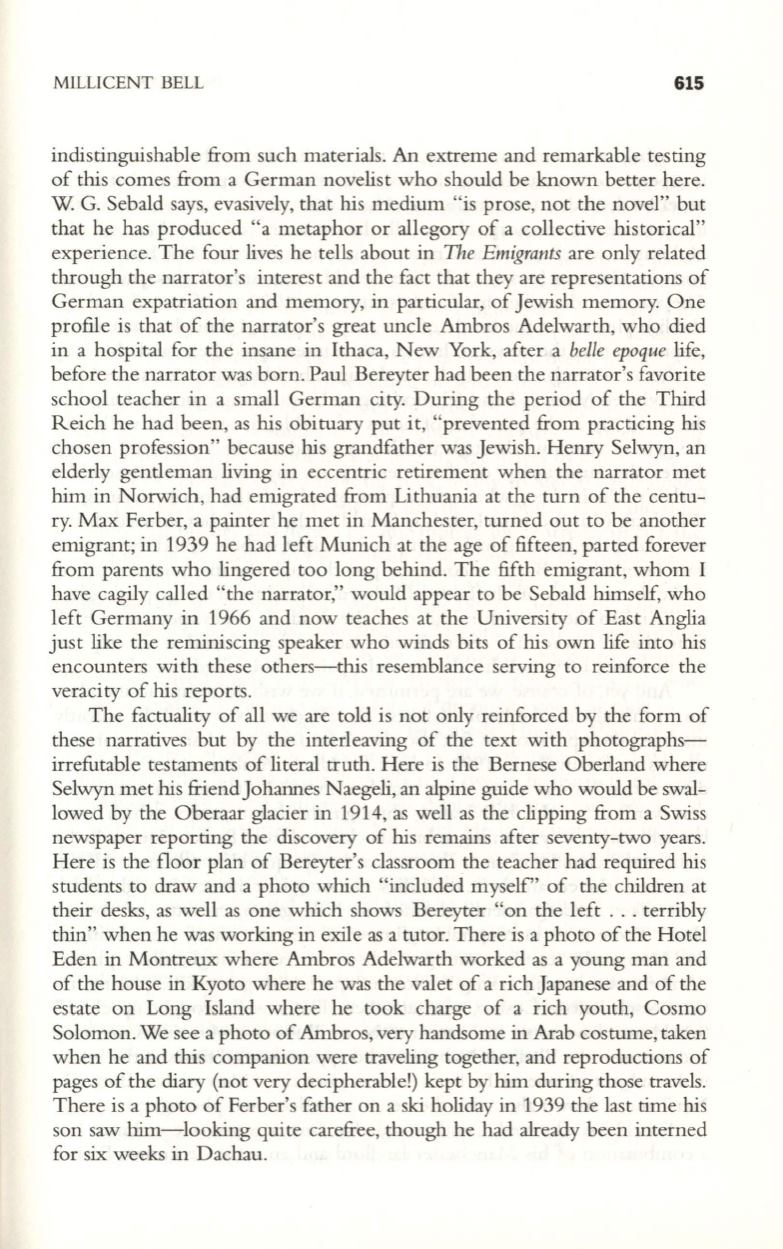
MlLLlCENT BELL
615
indistinguishable from such materials.
An
extreme and remarkable testing
of this comes from a German novelist who should be known better here.
W G. Sebald says, evasively, that his medium "is prose, not the novel" but
that he has produced "a metaphor or allegory of a collective historical"
experience. The four lives he tells about in
The Emigrants
are only related
through the narrator's interest and the fact that they are representations of
German expatriation and memory, in particular, of Jewish memory. One
profile is that of the narrator's great uncle Ambros Adelwarth, who died
in a hospital for the insane in Ithaca, New York, after a
belle epoque
life,
before the narrator was born. Paul Bereyter had been the narrator's favorite
school teacher in a small German city. During the period of the Third
Reich he had been, as his obituary put it, "prevented from practicing his
chosen profession" because his grandfather was Jewish. Henry Selwyn, an
elderly gentleman living in eccentric retirement when the narrator met
him
in Norwich, had emigrated from Lithuania at the turn of the centu–
ry. Max Ferber, a painter he met in Manchester, turned out to be another
emigrant; in 1939 he had left Munich at the age of fifteen, parted forever
from parents who lingered too long behind. The fifth emigrant, whom I
have cagily called "the narrator," would appear to be Sebald himself, who
left Germany in 1966 and now teaches at the University of East Anglia
just like the reminiscing speaker who winds bits of his own life into his
encounters with these others-this resemblance serving to reinforce the
veracity of his reports.
The factuality of all we are told is not only reinforced by the form of
these narratives but by the interleaving of the text with photographs–
irrefutable testaments of literal truth. Here is the Bernese Oberland where
Selwyn met his friend Johannes Naegeli, an alpine guide who would be swal–
lowed by the Oberaar glacier in 1914, as well as the clipping from a Swiss
newspaper reporting the discovery of his remains after seventy-two years.
Here is the floor plan of Bereyter's classroom the teacher had required his
students to draw and a photo which "included myself" of the children at
their desks, as well as one which shows Bereyter "on the left ... terribly
thin" when he was working in exile as a tutor. There is a photo of the Hotel
Eden in Montreux where Ambros Adelwarth worked as a young man and
of the house in Kyoto where he was the valet of a rich Japanese and of the
estate on Long Island where he took charge of a rich youth, Cosmo
Solomon. We see a photo of Ambros, very handsome in Arab costume, taken
when he and this companion were traveling together, and reproductions of
pages of the diary (not very decipherable!) kept by him during those travels.
There is a photo of Ferber's father on a ski holiday in 1939 the last time his
son saw him-looking quite carefree, though he had already been interned
for six weeks in Dachau.


